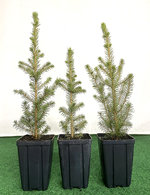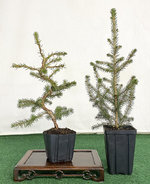I'm working on a rather comprehensive article on Ezo Spruce which will be released soon. But here is some of the text:
There are six spruce species native to the northern and high mountain regions of Japan. The “Ezo spruce,”
Picea glehnii is the best and most commonly trained spruce for bonsai in Japan. The correct name for this spruce is Red ezo spruce, Aka ezo matsu in Japanese, because of the opening reddish new growth. In the bonsai community it is commonly called Ezo spruce. Ezo is the old name for Hokkaido. A common name for this species is Sakhalin spruce in the horticultural community.
Another similarly named spruce, the Yeddo spruce,
Picea jezoensis, is commonly mistaken for the Ezo spruce, especially outside Japan. The correct name for this spruce is Black ezo spruce, Kuro ezo matsu, in Japanese because of the dark bark. This species is NOT trained for bonsai in Japan because of the large coarse needles which are about twice the size of the Red ezo spruce. I asked Mr. Kato, whose father was a pioneer and collector of Ezo spruce in northern Japan, about the difference between Red and Black ezo spruce and he told me, we never use Black ezo spruce because it is too large with coarse foliage. This species is often named Ezo spruce in the horticultural world, but is not the species trained for bonsai in Japan.
We are now assembling trees for our new Spring 2021 Seedling & Pre-Bonsai Catalog. One of the exciting new additions is Ezo spruce, which is extremely difficult to find in the United States.
The Ezo spruce, Picea glehnii, is the most famous and trained spruce for bonsai in Japan. A similar, but not used in Japan, is the Yeddo spruce, Picea jezoensis, which has large coarse foliage. A detailed article on the differences between Ezo and Yeddo spruce is forthcoming.
Our offering is for vigorous two year old container grown seedlings which are 8-12” tall. They are excellent for individual trees, forest and shohin bonsai and can also be grown to larger sizes as well. Although they will be listed in the new catalog they are now available in our Web Shop at:
www.internationalbonsai.com/page/1449429
Bill







